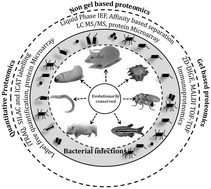当前位置:
X-MOL 学术
›
Mol. Biosyst.
›
论文详情
Our official English website, www.x-mol.net, welcomes your feedback! (Note: you will need to create a separate account there.)
Model system based proteomics to understand the host response during bacterial infections
Molecular BioSystems Pub Date : 2017-10-19 00:00:00 , DOI: 10.1039/c7mb00372b Arumugam Kamaladevi 1, 2, 3, 4, 5 , Shanmugam Marudhupandiyan 1, 2, 3, 4, 5 , Krishnaswamy Balamurugan 1, 2, 3, 4, 5
Molecular BioSystems Pub Date : 2017-10-19 00:00:00 , DOI: 10.1039/c7mb00372b Arumugam Kamaladevi 1, 2, 3, 4, 5 , Shanmugam Marudhupandiyan 1, 2, 3, 4, 5 , Krishnaswamy Balamurugan 1, 2, 3, 4, 5
Affiliation

|
Infectious diseases caused by bacterial pathogens pose a major concern to public health and, thus, greater attention must be given to providing insightful knowledge on host–pathogen interactions. There are several theories addressing the dynamics of complex mechanisms of host–pathogen interactions. The availability of an ample number of universally accepted model systems, including vertebrates, invertebrates, and mammalian cells, provides in-depth transcriptomics data to evaluate these complex mechanisms during host–pathogen interactions. Recent model system based proteomic studies have addressed the issues related to human diseases by establishing the protein profile of model animals that closely resemble the environment. As a result, model system based proteomics has been widely accepted as a powerful and effective approach to understand the highly complex host–pathogen interfaces at their protein levels. This review offers a snapshot of the contributions of selective model systems on host–bacterial pathogen interactions through proteomic approaches.
中文翻译:

基于蛋白质组学的模型系统了解细菌感染过程中的宿主反应
由细菌病原体引起的传染病是公共卫生的主要问题,因此,必须更加注意提供有关宿主与病原体相互作用的深入知识。有几种理论探讨宿主-病原体相互作用的复杂机制的动力学。包括脊椎动物,无脊椎动物和哺乳动物细胞在内的大量普遍接受的模型系统的可用性,提供了深入的转录组学数据,以评估宿主与病原体相互作用期间的这些复杂机制。最近的基于模型系统的蛋白质组学研究通过建立与环境非常相似的模型动物的蛋白质谱,解决了与人类疾病有关的问题。因此,基于模型系统的蛋白质组学已被广泛认为是一种了解蛋白质水平上高度复杂的宿主-病原体界面的强大而有效的方法。这篇综述简要介绍了选择性模型系统通过蛋白质组学方法对宿主-细菌病原体相互作用的贡献。
更新日期:2017-10-30
中文翻译:

基于蛋白质组学的模型系统了解细菌感染过程中的宿主反应
由细菌病原体引起的传染病是公共卫生的主要问题,因此,必须更加注意提供有关宿主与病原体相互作用的深入知识。有几种理论探讨宿主-病原体相互作用的复杂机制的动力学。包括脊椎动物,无脊椎动物和哺乳动物细胞在内的大量普遍接受的模型系统的可用性,提供了深入的转录组学数据,以评估宿主与病原体相互作用期间的这些复杂机制。最近的基于模型系统的蛋白质组学研究通过建立与环境非常相似的模型动物的蛋白质谱,解决了与人类疾病有关的问题。因此,基于模型系统的蛋白质组学已被广泛认为是一种了解蛋白质水平上高度复杂的宿主-病原体界面的强大而有效的方法。这篇综述简要介绍了选择性模型系统通过蛋白质组学方法对宿主-细菌病原体相互作用的贡献。


























 京公网安备 11010802027423号
京公网安备 11010802027423号